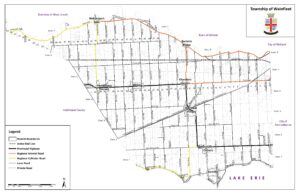Wainfleet Ontario
September 28, 2022 By: Keith Gracey
Location: 60822 Regional Rd 27, Wainfleet, ON, Canada

I currently live in the O’Reilly’s bridge neighbourhood of Wainfleet, ON, in the southern Niagara region. One of the best parts about where I currently live is that I live on the Welland River; in older documents referring to the area, including but not limited to documents about the War of 1812, this river would have been referred to as Chippewa Creek. Wainfleet was also formerly referred to as Marshville.
Pre-contact era – The Niagara region has a long history of habitation, with the earliest evidence coming from the carbon dating of mounds in Lewiston, NY, that proved to be from no later than the second century CE. However, this initial tribe of “mound builders” left around the 6th century. The Attowatians, or Neutrals, followed; they were referred to as neutrals due to their impartiality towards the wars between the Iroquois South of Lakes Erie and Ontario and the Huron to the north. The neutrals were initially hunters and gatherers; later, they did begin primitive farming, growing crops such as maize, berries, tobacco, and herbs. It is also believed that they could maintain their neutrality through trade which included all of the things they grew, and Onondaga chert (which is superior to other local chert varieties), allowing them the power to maintain neutrality.
Colonial era – The first known European to see Niagara Falls was Father Hennepin, a Roman Catholic priest from France, in 1679. In 1626 Father Joseph de La Roche Daillon spent time with the nation and estimated its population at approximately 40,000. Unfortunately, by 1640, when Brébeuf and Chaumonot visited 18 Neutral Nation settlements, the estimated population had been reduced to about 12,000 individuals. This population decrease is primarily believed to be the result of virgin soil epidemics brought on by contact with Europeans. in 1646, the last known chief of the neutrals passed away. Within seven years, the nation was destroyed. In 1648 the Iroquois began attacking the Huron. These attacks were believed to be very destructive and appalling, leading the neutral nation to harbour surviving Huron. Unfortunately, once the Iroquois discovered that the neutral nation was harbouring the Huron, they extended their war to include the neutral nation; this led to the destruction of the neutral nation by 1652. However, no nation took over the neutrals’ territory; most of their territory was abandoned for nearly 100 years.
This abandonment ended at the end of the American Revolutionary War. British Empire Loyalists who needed to flee what was now the United States of America were given land in the British Empire, and most of the loyalists moved to Upper Canada. The resettlement also included Mohawk natives who had been allied to the British forces.
Wainfleet, except for areas near Lake Erie, was a nearly impassible marsh until the 1820s, when the Welland canal was created. There was a second canal planned from the Grand River to connect with the Welland river/canal; unfortunately, during the construction of the first canal, it was determined that the Welland river could not be used for the motive water in the canal. The secondary canal was redirected to become a feeder canal designed to bring lake water into the main Welland canal. The creation of this feeder canal allowed for the draining of the Wainfleet peat bog, which opened the area for more agricultural development; as a result, farming is still the primary land use in Wainfleet today. In the 1850s, limestone quarries opened in the Southeastern portion of the Township; this coincided with the opening of railways in the Township.
Modern era – from 1901 until 1921, Wainfleet saw a population decrease. This is attributed mainly to railway development in the Prairie provinces and the availability of land in the prairies. This is also attributed to people leaving for the war and jobs supporting industrial war efforts in urban areas. Population took until 1941 to reach its 1901 levels again. However, the popularisation of the car and the availability of all-season roads led workers from nearby Port Colborne and Welland looking for lower taxes and country landscape to begin living in the rural Township. There have been no large-scale ecological changes in the area since the clearing of farmland in the late 1800s and early 1900s, and the local population has remained stable at around 6500 people for the last 30 years.